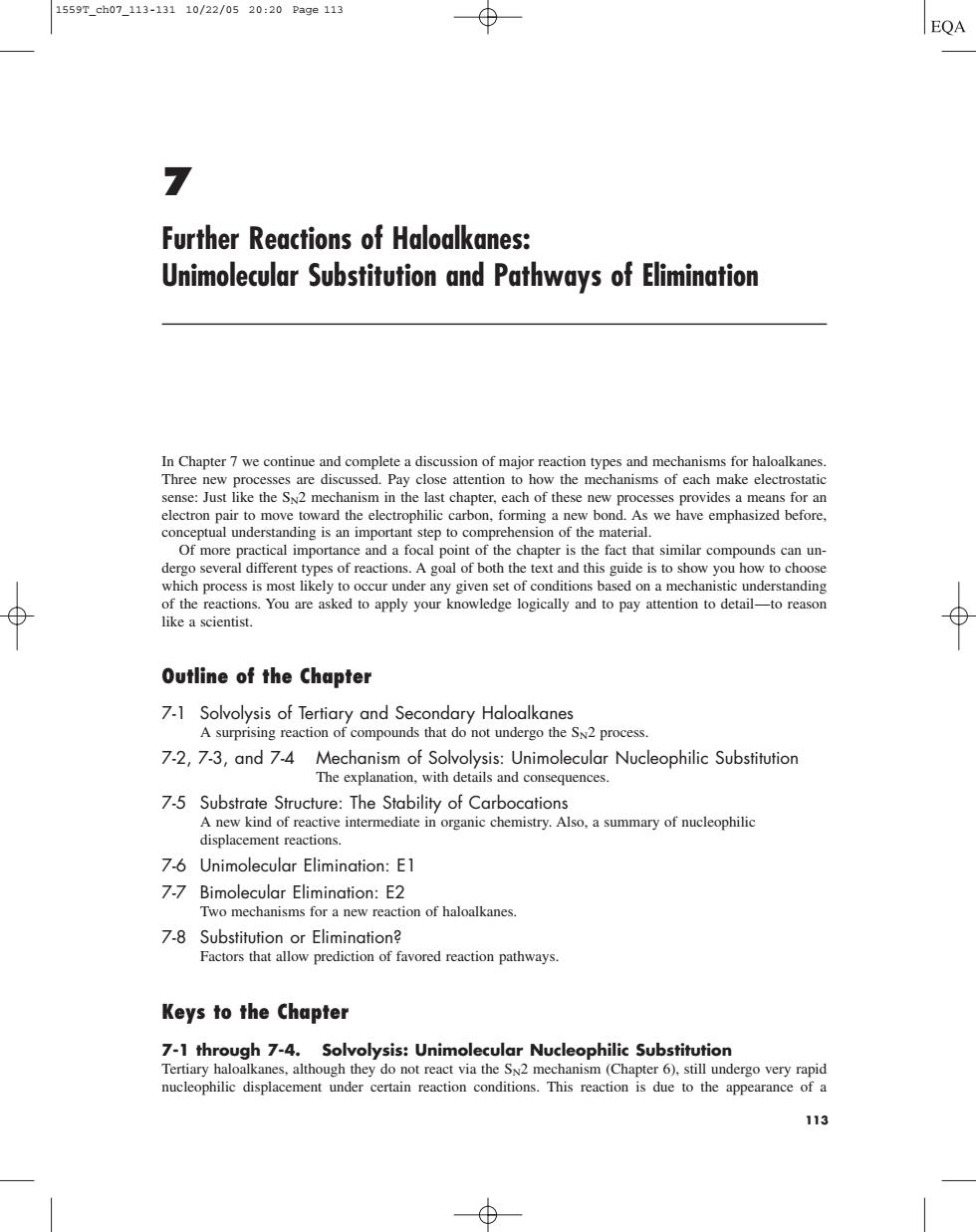正在加载图片...

1559T_ch07113-13110/22/0520:20Pa9e113 EQA 7 Further Reactions of Haloalkanes: Unimolecular Substitution and Pathways of Elimination In Chapter 7 we continue and complete a discussion of major reaction types and mechanisms for haloalkanes Pay electron pair to m vetoward the ophilic carbon,forming a new bond.As we have emphasized before. CO ing is an impo step to comprehension of the ma imilar e u der several different types of reactions.o of poth the textand this guide is to show you how to choose which process is most likely to occur under any given set of conditions based on a mechanistic understanding s.You are asked to apply your knowledge logically and to pay attention to detail-to reasor Outline of the Chapter 7-1 Solvolysis of Tertiary and Secondary Haloalkanes A surprising reaction of compounds that do not undergo the Sy2 process 7-2,7-3,and 7-4 Mechanism of Solvolysis:Unimolecular Nucleophilic Substitution The explanation.with details and conscquences. 7-5 Substrat displacement reactions. Also,a summary of nucleophilic 7-6 Unimolecular Elimination:E1 7-7 Bimolecular Elimination:E2 Two mechanisms for a new reaction of haloalkanes that allou Keys to the Chapter tho7.Solvolysis:Unimolecular Nucleophilic Substitution anes.although they 113 7 Further Reactions of Haloalkanes: Unimolecular Substitution and Pathways of Elimination In Chapter 7 we continue and complete a discussion of major reaction types and mechanisms for haloalkanes. Three new processes are discussed. Pay close attention to how the mechanisms of each make electrostatic sense: Just like the SN2 mechanism in the last chapter, each of these new processes provides a means for an electron pair to move toward the electrophilic carbon, forming a new bond. As we have emphasized before, conceptual understanding is an important step to comprehension of the material. Of more practical importance and a focal point of the chapter is the fact that similar compounds can undergo several different types of reactions. A goal of both the text and this guide is to show you how to choose which process is most likely to occur under any given set of conditions based on a mechanistic understanding of the reactions. You are asked to apply your knowledge logically and to pay attention to detail—to reason like a scientist. Outline of the Chapter 7-1 Solvolysis of Tertiary and Secondary Haloalkanes A surprising reaction of compounds that do not undergo the SN2 process. 7-2, 7-3, and 7-4 Mechanism of Solvolysis: Unimolecular Nucleophilic Substitution The explanation, with details and consequences. 7-5 Substrate Structure: The Stability of Carbocations A new kind of reactive intermediate in organic chemistry. Also, a summary of nucleophilic displacement reactions. 7-6 Unimolecular Elimination: E1 7-7 Bimolecular Elimination: E2 Two mechanisms for a new reaction of haloalkanes. 7-8 Substitution or Elimination? Factors that allow prediction of favored reaction pathways. Keys to the Chapter 7-1 through 7-4. Solvolysis: Unimolecular Nucleophilic Substitution Tertiary haloalkanes, although they do not react via the SN2 mechanism (Chapter 6), still undergo very rapid nucleophilic displacement under certain reaction conditions. This reaction is due to the appearance of a 113 1559T_ch07_113-131 10/22/05 20:20 Page 113